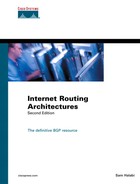Frequently Asked Questions
Q— How is VLSM different from subnetting?
A— It is not. VLSM is an extension of basic subnetting whereby the same Class A, B, or C address is subnetted by using masks of different lengths.
A— VLSM provides a more efficient way to assign IP addresses. It provides more flexibility in assigning adequate numbers of hosts and subnets given a limited number of IP addresses.
Q— What is the difference between CIDR and supernetting?
A— Classless inter-domain routing is the mechanism that allows networks to advertise both supernets and subnets outside the normal bounds of a classful network number. Supernetting is a representation that allows masks that are shorter than the natural masks, hence creating supernets.
Q— Is the classful model the cause of the growth in the global routing tables?
A— No. The growth of the routing tables is due to more organizations connecting to the Internet. The classful model does not offer a scalable solution to cope with such growth.
Q— I have a network that uses older protocols such as RIP-1 and IGRP. What issues should I consider in deciding whether to upgrade to newer protocols that support VLSM and CIDR?
A— If you feel that implementing VLSM and CIDR can help you utilize your address space more efficiently and will give you better route summarization capabilities, you should upgrade. One issue could be whether your current hardware is capable of running newer protocols that might need extra processing or memory requirements. Of course, this depends on the protocol to which you are upgrading. Other issues involve the coexistence of new and old protocols. Because network upgrades are usually done in stages, you will be faced with situations where both older and newer protocols are running concurrently. Because older classful routing protocols cannot deal with VLSM or CIDR, you should not be surprised that extensive use of static routing might be required to ensure connectivity in your domain during the transition period.
Q— Can I aggregate any routes in my routing table?
A— You can aggregate only routes that you administer. Aggregating routes that are not an extension of your domain could create black holes.
Q— If I leave my provider, can I keep my IP addresses?
A— For the purposes of better aggregation, today's routing practices recommend (sometimes require) that you return the old addresses and get addresses from your new provider. Ask your provider for its policies.
Q— I have some hosts that require Internet connectivity and others that do not. Can I use private addresses on some hosts and not others?
A— Yes, you can use both private and global addresses in the same network. When advertising routes to your provider, you advertise only the legal (nonprivate) networks.
Q— I need to connect to the Internet, and not all my addresses are registered. I can't afford to renumber. What should I do?
A— You could use Network Address Translation (NAT) to map your invalid address to a legitimate pool of addresses that you get from your provider.
